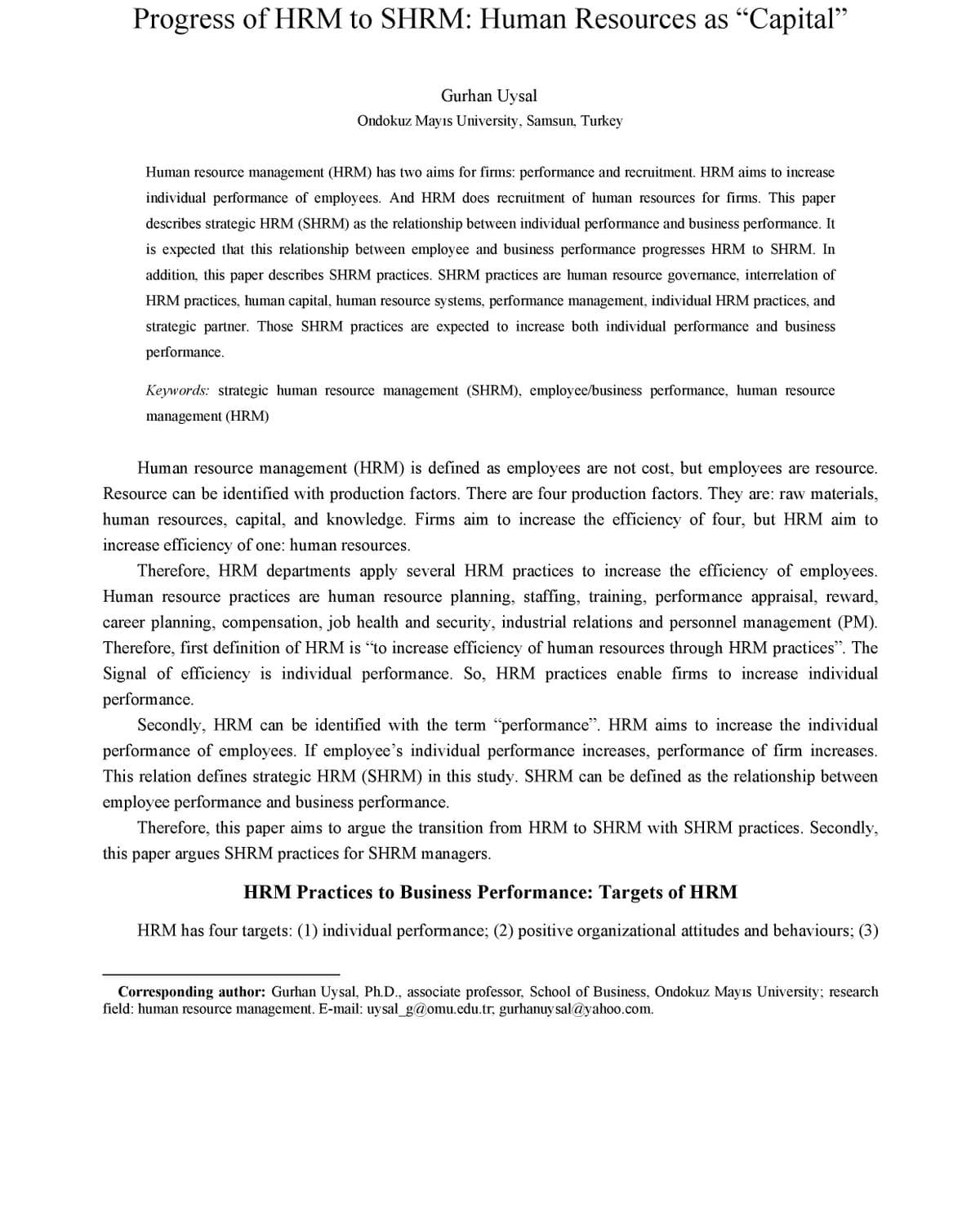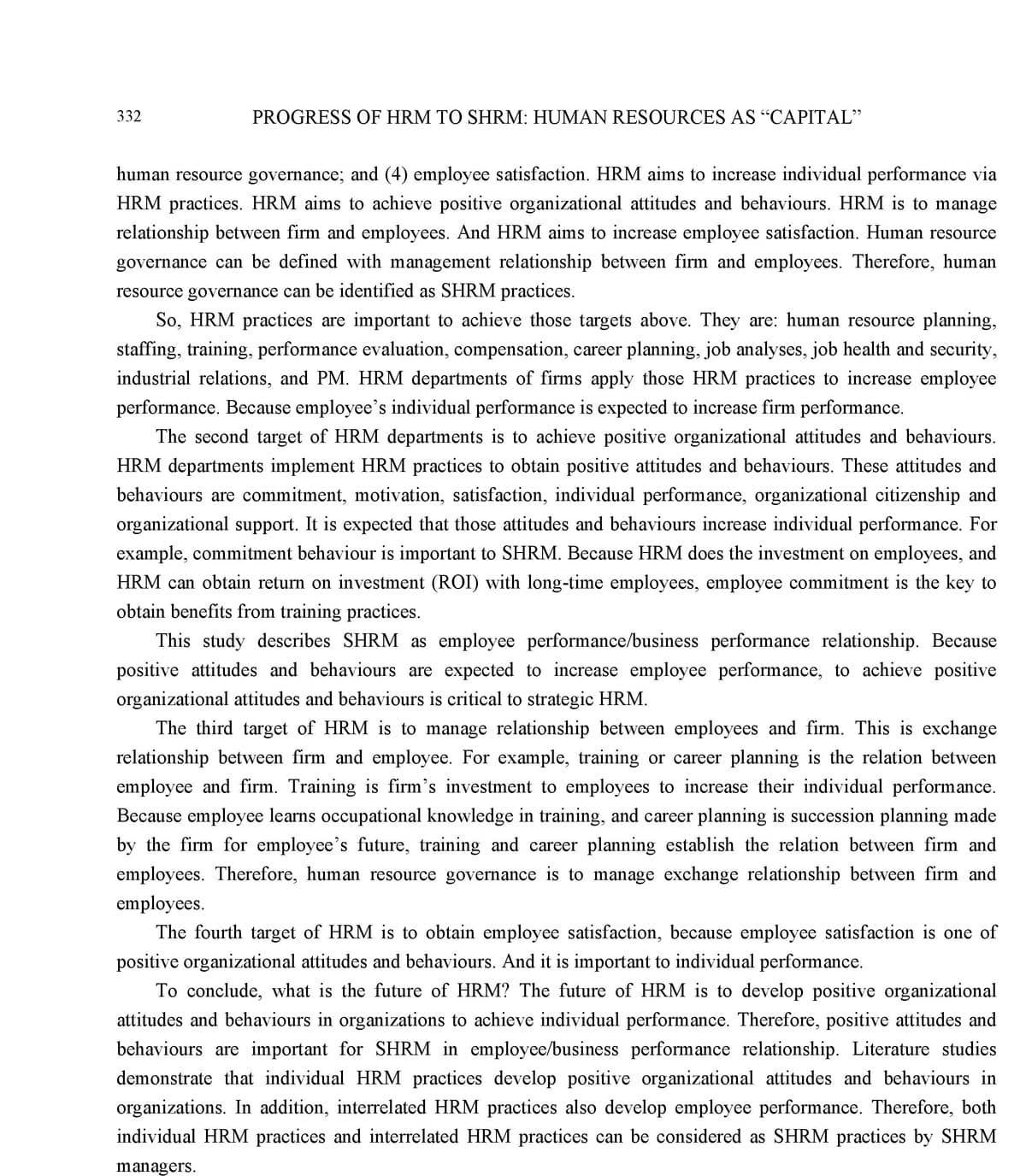literature review JUST on the concept of HRM and SHRM.
Management, Loose-Leaf Version
13th Edition
ISBN:9781305969308
Author:Richard L. Daft
Publisher:Richard L. Daft
Chapter19: Managing Quality And Performance
Section: Chapter Questions
Problem 2OTJVC
Related questions
Question
1. literature review JUST on the concept of HRM and SHRM.

Transcribed Image Text:Progress of HRM to SHRM: Human Resources as "Capital"
99
Gurhan Uysal
Ondokuz Mayıs University, Samsun, Turkey
Human resource management (HRM) has two aims for firms: performance and recruitment. HRM aims to increase
individual performance of employees. And HRM does recruitment of human resources for firms. This paper
describes strategic HRM (SHRM) as the relationship between individual performance and business performance. It
is expected that this relationship between employee and business performance progresses HRM to SHRM. In
addition, this paper describes SHRM practices. SHRM practices are human resource governance, interrelation of
HRM practices, human capital, human resource systems, performance management, individual HRM practices, and
strategic partner. Those SHRM practices are expected to increase both individual performance and business
performance.
Keywords: strategic human resource management (SHRM), employee/business performance, human resource
management (HRM)
Human resource management (HRM) is defined as employees are not cost, but employees are resource.
Resource can be identified with production factors. There are four production factors. They are: raw materials,
human resources, capital, and knowledge. Firms aim to increase the efficiency of four, but HRM aim to
increase efficiency of one: human resources.
Therefore, HRM departments apply several HRM practices to increase the efficiency of employees.
Human resource practices are human resource planning, staffing, training, performance appraisal, reward,
career planning, compensation, job health and security, industrial relations and personnel management (PM).
Therefore, first definition of HRM is "to increase efficiency of human resources through HRM practices". The
Signal of efficiency is individual performance. So, HRM practices enable firms to increase individual
performance.
Secondly, HRM can be identified with the term "performance". HRM aims to increase the individual
performance of employees. If employee's individual performance increases, performance of firm increases.
This relation defines strategic HRM (SHRM) in this study. SHRM can be defined as the relationship between
employee performance and business performance.
Therefore, this paper aims to argue the transition from HRM to SHRM with SHRM practices. Secondly,
this paper argues SHRM practices for SHRM managers.
HRM Practices to Business Performance: Targets of HRM
HRM has four targets: (1) individual performance; (2) positive organizational attitudes and behaviours; (3)
Corresponding author: Gurhan Uysal, Ph.D., associate professor, School of Business, Ondokuz Mayıs University; research
field: human resource management. E-mail: uysal_g@omu.edu.tr; gurhanuy sal@yahoo.com.

Transcribed Image Text:332
PROGRESS OF HRM TO SHRM: HUMAN RESOURCES AS “CAPITAL"
human resource governance; and (4) employee satisfaction. HRM aims to increase individual performance via
HRM practices. HRM aims to achieve positive organizational attitudes and behaviours. HRM is to manage
relationship between firm and employees. And HRM aims to increase employee satisfaction. Human resource
governance can be defined with management relationship between firm and employees. Therefore, human
resource governance can be identified as SHRM practices.
So, HRM practices are important to achieve those targets above. They are: human resource planning,
staffing, training, performance evaluation, compensation, career planning, job analyses, job health and security,
industrial relations, and PM. HRM departments of firms apply those HRM practices to increase employee
performance. Because employee's individual performance is expected to increase firm performance.
The second target of HRM departments is to achieve positive organizational attitudes and behaviours.
HRM departments implement HRM practices to obtain positive attitudes and behaviours. These attitudes and
behaviours are commitment, motivation, satisfaction, individual performance, organizational citizenship and
organizational support. It is expected that those attitudes and behaviours increase individual performance. For
example, commitment behaviour is important to SHRM. Because HRM does the investment on employees, and
HRM can obtain return on investment (ROI) with long-time employees, employee commitment is the key to
obtain benefits from training practices.
This study describes SHRM as employee performance/business performance relationship. Because
positive attitudes and behaviours are expected to increase employee performance, to achieve positive
organizational attitudes and behaviours is critical to strategic HRM.
The third target of HRM is to manage relationship between employees and firm. This is exchange
relationship between firm and employee. For example, training or career planning is the relation between
employee and firm. Training is firm's investment to employees to increase their individual performance.
Because employee learns occupational knowledge in training, and career planning is succession planning made
by the firm for employee's future, training and career planning establish the relation between firm and
employees. Therefore, human resource governance is to manage exchange relationship between firm and
employees.
The fourth target of HRM is to obtain employee satisfaction, because employee satisfaction is one of
positive organizational attitudes and behaviours. And it is important to individual performance.
To conclude, what is the future of HRM? The future of HRM is to develop positive organizational
attitudes and behaviours in organizations to achieve individual performance. Therefore, positive attitudes and
behaviours are important for SHRM in employee/business performance relationship. Literature studies
demonstrate that individual HRM practices develop positive organizational attitudes and behaviours in
organizations. In addition, interrelated HRM practices also develop employee performance. Therefore, both
individual HRM practices and interrelated HRM practices can be considered as SHRM practices by SHRM
managers.
Expert Solution
This question has been solved!
Explore an expertly crafted, step-by-step solution for a thorough understanding of key concepts.
Step by step
Solved in 2 steps

Knowledge Booster
Learn more about
Need a deep-dive on the concept behind this application? Look no further. Learn more about this topic, management and related others by exploring similar questions and additional content below.Recommended textbooks for you

Management, Loose-Leaf Version
Management
ISBN:
9781305969308
Author:
Richard L. Daft
Publisher:
South-Western College Pub

Management, Loose-Leaf Version
Management
ISBN:
9781305969308
Author:
Richard L. Daft
Publisher:
South-Western College Pub